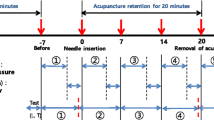Abstract
Purpose
Acupuncture stimulation is known to act on the autonomic nervous system and elicits depressor and bradycardic effects. However, previous studies on humans did not conduct quantitative analyses on optimal acupuncture conditions such as the stimulation frequency and duration to achieve maximum depressor and bradycardic effects. The aim of the present study was to investigate the effects of varying stimulation frequencies of electroacupuncture on time-dependent changes in blood pressure and heart rate in humans.
Methods
Twelve healthy volunteers participated in the study. An acupuncture needle was inserted at the Ximen acupoint (PC4 according to WHO nomenclature), located at the anterior aspect of the forearm. An electrical stimulation was delivered through the acupuncture needle at an intensity of 1 V, pulse width of 5 ms, and stimulation frequencies of 0.5, 1, 5, and 10 Hz in a random order. The duration of electroacupuncture was 6 min, during which blood pressure and heart rate responses were monitored.
Results
Group-averaged data indicated that 1-Hz electroacupuncture decreased blood pressure and heart rate. Blood pressure was significantly decreased from the prestimulation baseline value of 86.6 ± 2.9 to 81.4 ± 2.3 mmHg during 4–6 min of 1-Hz electroacupuncture (mean ± SE, P < 0.01). Heart rate was also significantly decreased (from 66.2 ± 2.0 to 62.7 ± 1.7 beats/min, P < 0.01).
Conclusions
These results provide fundamental evidence that bradycardiac and depressor responses are effectively produced by electrical acupuncture in humans.



Similar content being viewed by others
References
Bäcker M, Hammes MG, Valet M, Deppe M, Conrad B, Tölle TR, Dobos G (2002) Different modes of manual acupuncture stimulation differentially modulate cerebral blood flow velocity, arterial blood pressure and heart rate in human subjects. Neurosci Lett 333:203–206
Han JS (2003) Acupuncture: neuropeptide release produced by electrical stimulation of different frequencies. Trends Neurosci 26(1):17–22
Kawada T, Shimizu S, Yamamoto H, Shishido T, Kamiya A, Miyamoto T, Sunagawa K, Sugimachi M (2009) Servo-controlled hind-limb electrical stimulation for short-term arterial pressure control. Circ J 73:851–859
Lechat P, Hulot JS, Escolano S, Mallet A, Leizorovicz A, Werhlen-Grandjean M, Pochmalicki G, Dargie H (2001) Heart rate and cardiac rhythm relationships with bisoprolol benefit in chronic heart failure in CIBIS II Trial. Circulation 103:1428–1433
Li M, Zheng C, Sato T, Kawada T, Sugimachi M, Sunagawa K (2004) Vagal nerve stimulation markedly improves long-term survival after chronic heart failure in rats. Circulation 109:120–124
Li M, Zheng C, Kawada T, Inagaki M, Uemura K, Shishido T, Sugimachi M (2013) Donepezil markedly improves long-term survival in rats with chronic heart failure after extensive myocardial infarction. Circ J 77:2519–2525
Li M, Zheng C, Kawada T, Inagaki M, Uemura K, Sugimachi M (2014) Adding the acetylcholinesterase inhibitor, donepezil, to losartan treatment markedly improves long-term survival in rats with chronic heart failure. Eur J Heart Fail 16:1056–1065
Li P, Ayannusi O, Reid C, Longhurst JC (2004) Inhibitory effect of electroacupuncture (EA) on the pressor response induced by exercise stress. Clin Auton Res 14(3):182–188
Li P, Longhurst JC (2010) Neural mechanism of electroacupuncture’s hypotensive effects. Auton Neurosci 157(1–2):24–30
Li P, Rowshan K, Crisostomo M, Tjen-A-Looi SC, Longhurst JC (2002) Effect of electroacupuncture on pressor reflex during gastric distension. Am J Physiol Regul Integr Comp Physiol 283(6):1335–1345
Ma L, Cui B, Shao Y, Ni B, Zhang W, Luo Y, Zhang S (2014) Electroacupuncture improves cardiac function and remodeling by inhibition of sympathoexcitation in chronic heart failure rats. Am J Physiol Heart Circ Physiol 306:H1464–H1471
Michikami D, Kamiya A, Kawada T, Inagaki M, Shishido T, Yamamoto K, Ariumi H, Iwase S, Sugenoya J, Sunagawa K, Sugimachi M (2006) Short-term electroacupuncture at Zusanli resets the arterial baroreflex neural arc toward lower sympathetic nerve activity. Am J Physiol Heart Circ Physiol 291:H318–H326
Nakahara H, Kawada T, Yamamoto H, Sugimachi M, Miyamoto T (2010) Effect of low-frequency electrical acupuncture on heart rate: reproducibility and influence of stimulation depth. Circ Control 31(1):28–35 (in Japanese with an English abstract)
Nishijo K, Mori H, Yosikawa K, Yazawa K (1997) Decreased heart rate by acupuncture stimulation in humans via facilitation of cardiac vagal activity and suppression of cardiac sympathetic nerve. Neurosci Lett 227:165–168
Ohsawa H, Okada K, Nishijo K, Sato Y (1995) Neural mechanism of depressor responses of arterial pressure elicited by acupuncture-like stimulation to a hindlimb in anesthetized rats. J Auton Nerv Syst 51(1):27–35
Packer M, Coats AJ, Fowler MB, Katus HA, Krum H, Mohacsi P, Rouleau JL, Tendera M, Castaigne A, Roecker EB, Schultz MK, DeMets DL (2001) Effect of carvedilol on survival in severe chronic heart failure. N Engl J Med 344:1651–1658
Triposkiadis F, Karayannis G, Giamouzis G, Skoularigis J, Louridas G, Butler J (2009) The sympathetic nervous system in heart failure. Physiology, pathophysiology, and clinical implications. J Am Coll Cardiol 54:1747–1762
Uchida S, Kagitani F, Hotta H (2008) Mechanism of the reflex inhibition of heart rate elicited by acupuncture-like stimulation in anesthetized rats. Auton Neurosci 143:12–19
Uchida S, Shimura M, Ohsawa H, Suzuki A (2007) Neural mechanism of bradycardiac responses elicited by acupuncture-like stimulation to a hind limb in anesthetized rats. J Physiol Sci 57:377–382
Yamamoto H, Kawada T, Kamiya A, Kita T, Sugimachi M (2008) Electroacupuncture changes the relationship between cardiac and renal sympathetic nerve activities in anesthetized cats. Auton Neurosci 144:43–49
Zhou W, Fu L-W, Tjen-A-Looi SC, Li P, Longhurst JC (2005) Afferent mechanisms underlying stimulation modality-related modulation of acupuncture-related cardiovascular responses. J Appl Physiol 98:872–880
Acknowledgments
This study was supported in part by a Grant-in-Aid for Scientific Research (No. 24700768) from the Japanese Ministry of Education, Culture, Sports, Science and Technology.
Author information
Authors and Affiliations
Corresponding author
Ethics declarations
Conflict of interest
The authors have no conflict of interest to declare.
Rights and permissions
About this article
Cite this article
Nakahara, H., Kawada, T., Ueda, Sy. et al. Electroacupuncture most effectively elicits depressor and bradycardic responses at 1 Hz in humans. Clin Auton Res 26, 59–66 (2016). https://doi.org/10.1007/s10286-015-0330-x
Received:
Accepted:
Published:
Issue Date:
DOI: https://doi.org/10.1007/s10286-015-0330-x




